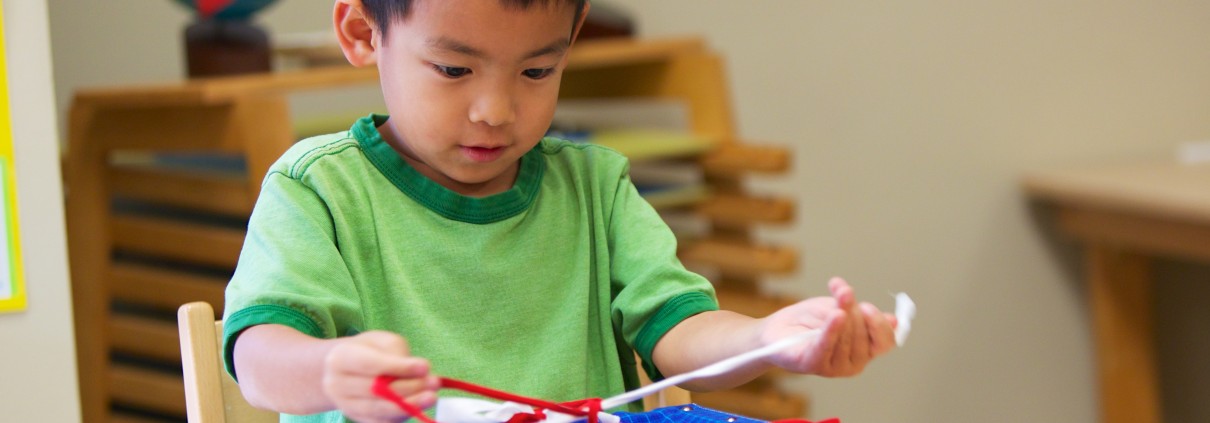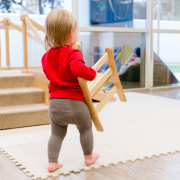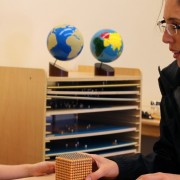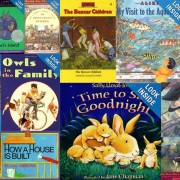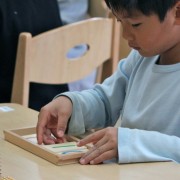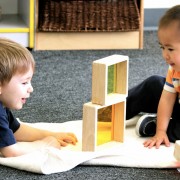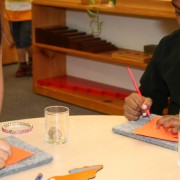How to help your four-year-old transition into Montessori
 Some parents who discover Montessori when their child is four years old are concerned about joining the mixed-age primary room mid-stream. “Will my child be playing catch-up? Some of the other four-year-olds are already reading ”, you might wonder. “I’ve just learned about Montessori, and I see how wonderful this environment could be for my child. She’s already four, though. Did we miss the boat?”
Some parents who discover Montessori when their child is four years old are concerned about joining the mixed-age primary room mid-stream. “Will my child be playing catch-up? Some of the other four-year-olds are already reading ”, you might wonder. “I’ve just learned about Montessori, and I see how wonderful this environment could be for my child. She’s already four, though. Did we miss the boat?”
The short answer: Four is not too late! We’ve seen many four-year-olds blossom in our schools, just taking off in their personal development after joining our classrooms, and your child can, too.
 It is true that younger is better when it comes to joining a Montessori program. Starting as a toddler or a young three-year-old gives children the best opportunity to benefit from the enriched, carefully prepared classroom environment. As Montessori educators, we understand that the time between birth and age six is the most critical in a human being’s development. During this stage of growth, children go through rapid changes and develop the most important aspects of their personality and intellect.
It is true that younger is better when it comes to joining a Montessori program. Starting as a toddler or a young three-year-old gives children the best opportunity to benefit from the enriched, carefully prepared classroom environment. As Montessori educators, we understand that the time between birth and age six is the most critical in a human being’s development. During this stage of growth, children go through rapid changes and develop the most important aspects of their personality and intellect.
Dr. Maria Montessori discovered that much of this change occurs through active experiences children have with their environment — at home, outside, or at school. Children between the ages of three and six go through what Dr. Montessori called “sensitive periods,” periods where they are naturally primed to absorb skills and knowledge in a wide range of areas. During these sensitive periods children can, for example, effortlessly acquire language skills (including learning to write and read), develop what is now called “executive function skills”(such as sustaining concentration, learning self-control, and strengthen their working memory), learn to interact graciously with others, and refine all their senses.
 While some of these sensitive periods begin at birth, four-year-old children are still in the midst of this amazing time. We regularly see four-year-olds join our class and become drawn to the materials on our shelves; they quickly begin “working” and become acclimated to their new environment. With the right support at home and at school, you’ll be surprised by how much joy both you and your child will get from his Montessori experience!
While some of these sensitive periods begin at birth, four-year-old children are still in the midst of this amazing time. We regularly see four-year-olds join our class and become drawn to the materials on our shelves; they quickly begin “working” and become acclimated to their new environment. With the right support at home and at school, you’ll be surprised by how much joy both you and your child will get from his Montessori experience!
How to help your four-year-old transition joyfully into the Montessori environment
1. Enroll your child for five full days per week
By the time your child reaches four and is no longer napping, she is ready to attend school for five full days per week. A child who attends school for five days each week has the greatest opportunity for consistent spontaneous learning and will feel safe and relaxed in the classroom. The full day schedule (8:30 am to 3:00 pm) also allows the child to have more time to work through the materials during the morning and afternoon work cycles, and to receive many lessons from her teacher.
 This consistent time is especially important for your four-year-old who is new to Montessori. Dr. Montessori observed that many issues that children struggle with, from temper tantrums to uncoordinated movement, from disobedience to physical aggression, disappeared when children are allowed freedom in an environment suited to their needs. Often, a child would find some activity that spoke to him, become immersed in it, and repeat it over and over again. Once a child connected to an engaging activity, he became happier, more curious to explore more learning materials in class, and even became kinder and more benevolent to his peers.
This consistent time is especially important for your four-year-old who is new to Montessori. Dr. Montessori observed that many issues that children struggle with, from temper tantrums to uncoordinated movement, from disobedience to physical aggression, disappeared when children are allowed freedom in an environment suited to their needs. Often, a child would find some activity that spoke to him, become immersed in it, and repeat it over and over again. Once a child connected to an engaging activity, he became happier, more curious to explore more learning materials in class, and even became kinder and more benevolent to his peers.
For an older child, this process may take some time; he may need to wander, try different activities, and observe his peers, before he discovers something that would like to work with. By enrolling your child for five full days, you can give him that luxury of time, and help him get the most out of his two Montessori primary years.
2. Be open to keeping your child in Montessori through the 3rd year of Primary
 The third year in Montessori Primary (the equivalent of traditional kindergarten) is the year when much of the foundational skill development solidifies, and many children suddenly experience huge growth spurts in writing, reading, math and overall confidence.
The third year in Montessori Primary (the equivalent of traditional kindergarten) is the year when much of the foundational skill development solidifies, and many children suddenly experience huge growth spurts in writing, reading, math and overall confidence.
Since your child would be joining during the second year of Montessori Primary, it is even more important for him to get to experience the third year. From age four to five, he’ll be working hard on many foundational skills, from fine motor control to concentration, from learning to observe carefully to mastering multi-step processes. If you keep him in Montessori for only one year, he’ll never get to experience the astounding mastery he will attain from his hard work. He’ll likely be just at the cusp of reading, just about ready to tackle the fun advanced math materials, and eager to move from being the rookie to becoming a classroom leader.
Parents are often amazed at what they see during the kindergarten year. Please do consider giving your child this experience! While we do not, of course, require you to sign on for two years now, we do want to caution you against viewing Montessori as a one-year, pre-k experience aimed at getting your child ready for traditional kindergarten. That’s not how Montessori works, and we wouldn’t want you to sign on with wrong expectations!
3. Learn about Montessori
 The best way to help your child thrive in a Montessori environment is to better understand Montessori yourself. We make this easy for you: When your child joins our program, you’ll receive eight short, one-page handouts explaining key aspects of Montessori, and suggesting simple ways you can align what you do at home with what your child experiences at school. Throughout the school year, we offer Parent Education Events, where we discuss a wide range of topics: from how to support independence to learning math in preschool. Our blog also offers plenty of helpful articles. Your child’s teacher is also a great resource: Our trained head teachers are available via email or in person after school to answer all kinds of Montessori-related questions you may have and to help you understand how you can best support your child.
The best way to help your child thrive in a Montessori environment is to better understand Montessori yourself. We make this easy for you: When your child joins our program, you’ll receive eight short, one-page handouts explaining key aspects of Montessori, and suggesting simple ways you can align what you do at home with what your child experiences at school. Throughout the school year, we offer Parent Education Events, where we discuss a wide range of topics: from how to support independence to learning math in preschool. Our blog also offers plenty of helpful articles. Your child’s teacher is also a great resource: Our trained head teachers are available via email or in person after school to answer all kinds of Montessori-related questions you may have and to help you understand how you can best support your child.
4. Support independence at home
“Never help the child do something that he thinks he can do for himself” — this is one of Dr. Montessori’s most famous quotes! Our classrooms and activities are set up so your four-year-old child will quickly learn to take care of his own needs such as getting dressed without help, pouring his own drink, and preparing snacks. Children love this new-found independence, and you can help your child feel just as empowered at home. Here is a blog post that describes some simple changes you can make to support your child’s budding independence at home.
5. Don’t compare your child with other children in the classroom
 One of the beauties of Montessori is the profound respect for the individuality we give each child. Montessori teachers do not compare their students with each other. We know that your four-year-old may need some time to get used to his new school, and that it would not help at all to compare him to other four-year-olds who had started before him. Each Montessori teacher allows her students to develop at their own pace, and she trusts that the Montessori classroom will enable her students to reach their individual potential at their own unique pace.
One of the beauties of Montessori is the profound respect for the individuality we give each child. Montessori teachers do not compare their students with each other. We know that your four-year-old may need some time to get used to his new school, and that it would not help at all to compare him to other four-year-olds who had started before him. Each Montessori teacher allows her students to develop at their own pace, and she trusts that the Montessori classroom will enable her students to reach their individual potential at their own unique pace.
We encourage you to take the same long-term perspective: Be patient and do not rush your child. Don’t put performance pressure on her by comparing her, even subtly, to the other children in the class. Yes, it can be hard to see other four-year-olds reading, while your new Montessori child may be preparing snack or working with the color tablets instead. Just know that by stepping back and letting her discover and explore her surroundings, you are enabling her to do very important foundational work. Once she’s ready, she may just surprise you with how quickly she “explodes” into writing and reading!
6. Do not introduce other academics at home
With today’s competitive environment, it’s easy to feel that your four-year-old needs to learn her letters or start to work on addition facts. Some parents become anxious and to want to accelerate their child’s learning by providing extra academics. Often, well-meaning, conscientious parents buy workbooks for their children to complete or enroll their preschoolers in structured academic programs, such as Kumon. We strongly advise against this!
Trust that your child’s teacher is introducing your child to academic skills that are developmentally appropriate for her. Support what your child is doing at school and do not introduce other academics at home that are contrary to what your child is learning at school. Enrolling in Kumon, making children complete worksheets, teaching letter names, writing letters and counting on fingers will only confuse your child! If you want to do more to foster literacy, this blog post provides some Montessori-consistent ideas you can follow at home.
7. Read, read, read at home
 If you want to support your child’s academic development, the best way to do this is to read with your child. Read a lot! Read a variety of books, discuss what you read, ask her questions about what you’ve read, follow along with your finger under text as you read, and explain vocabulary. That way, when she does finally master her letter sounds, she’ll be able to move along much faster. You can read more about how to apply Montessori ideas to reading here, find suggestions for setting up an environment that fosters literacy here, and view our thoughts on selecting books (and actual book lists), in this blog post.
If you want to support your child’s academic development, the best way to do this is to read with your child. Read a lot! Read a variety of books, discuss what you read, ask her questions about what you’ve read, follow along with your finger under text as you read, and explain vocabulary. That way, when she does finally master her letter sounds, she’ll be able to move along much faster. You can read more about how to apply Montessori ideas to reading here, find suggestions for setting up an environment that fosters literacy here, and view our thoughts on selecting books (and actual book lists), in this blog post.
We hope these points helped you understand how giving your child a Montessori education is a true gift that will last her a lifetime, and that with your enthusiastic support, your four-year-old will thrive in her new Montessori environment.

